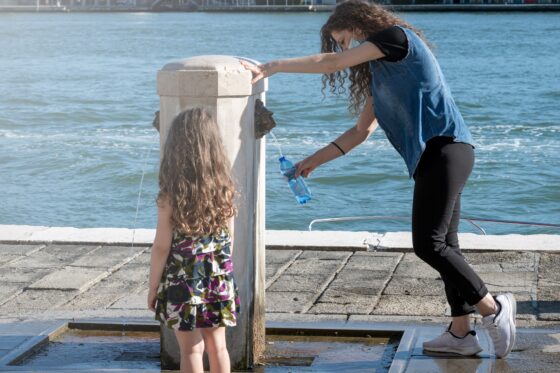
A stone’s throw from the famous Piazza San Marco in Venice, a little girl fills her water bottle under the gaze of her father at the fountain installed in the shaded courtyard of their hotel, a haven of peace sheltered from the hordes of tourists.
“I hate plastic bottles (…) there is so much plastic in the oceans and everywhere else”explains the height of her 11 years Keira, who came with her father Charlie Michieli from Tucson in Arizona. “Carrying my water bottle is super easy, it’s not heavy and it lasts a super long time”specifies the budding ecologist with a halo of long blond hair.
His father is also a fan of gourds: “During a long journey you can consume liters and liters of plastic bottles”he laments, proudly brandishing his own fuchsia fireworks.
In a city like Venice, which receives millions of visitors every year, tourism contributes to the production of between 28 and 40% of the waste, depending on the season, according to figures communicated to AFP by the town hall.
126 fountains in the historic center of Venice
The decrease in the consumption of plastic bottles is therefore not anecdotal, which is why the local authorities have decided to promote the use of gourds by highlighting the network of drinking water fountains that punctuate the squares and alleys of the Serenissima.
“In the historic center there are 126 fountains spread over all the neighborhoods, they are easy to find, there is one almost every hundred meters”illustrates in his office in the town hall overlooking the Rialto Bridge the architect Alberto Chinellato, responsible for roads.
To make it easier for tourists, there is even a smartphone application developed by Veritas, the water company, “which gives access to a map with all the fountains available on Venetian territory”. By activating their GPS, the tourist can “can find the shortest way to fill his water bottle”.
And all this of course in the well-understood interest of the city, because “promoting the use of free drinking water makes it possible to produce less waste (…) but also to transport fewer bottles to the historic center, which means less pollution and less transport”emphasizes Alberto Chinellato.
However, when leaving City Hall, an empty plastic water bottle swinging between two gondolas on the waters of the Grand Canal reminds us that the battle against plastic is far from being won.
In Hotel Flora, where our two American tourists stay, the owner has also decided to contribute to the crusade against plastic by raising awareness among its customers.
Towards a tax for day care centers?
“We just had a map printed on which we marked the fountains of Venice with a little blue drop”says Gioele Romanelli, proudly displaying a copy on a small bistro table. “Not only with a water bottle, but also by recycling a small bottle of water you can last all day”says the 49-year-old hotelier.
At the time of check-in, all customers are therefore informed and their “reaction is always enthusiastic”he rejoices. “And she and she are sometimes surprised to learn that the water in Venice is drinkable.”
“With this small gesture, our customers can actively participate in the fight against plastic,” he says, seeing it as a way to convey a certain sense of “responsibility” in a city “which has an insane amount of tourists”. . “.
In addition to his small printed card, along the way, Gioele Romanelli has removed the monodoses of shampoo and shower gel in the rooms in favor of rechargeable dispensers installed in the bathrooms.
Finally, “At breakfast, we completely eliminated plastic by using small glass containers for muesli, dried fruit, yogurt…”
While Venice is gradually regaining its tourist numbers after the pandemic, which reached 5.5 million visitors in 2019 (for 50,000 inhabitants!), the municipality also wants to limit arrivals by introducing a tax for all visitors who only visit during the day from January 2023. and who have so far escaped the tourist tax.
This tax, payable online on a special site that allows to obtain a verifiable QR code at the entrances to the city, will be three to ten euros, depending on the influx.
(AFP)